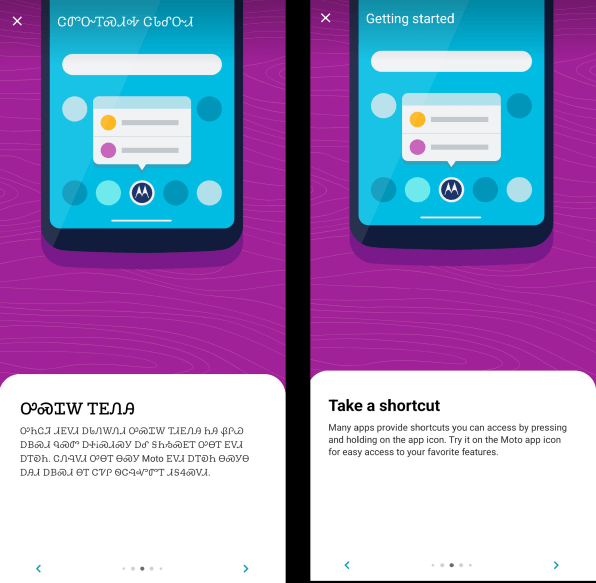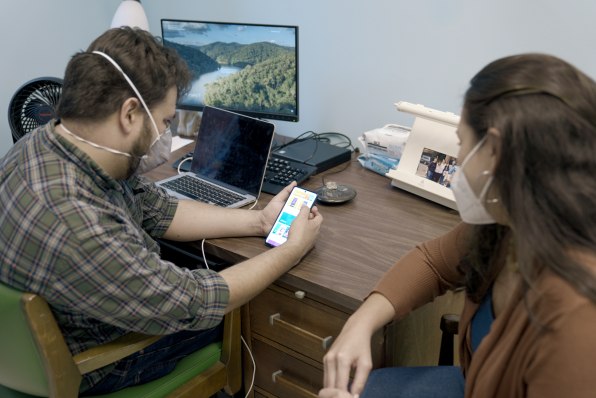[ad_1]
In the spring of 2021, Motorola added support for two Indigenous languages spoken in Latin America as part of a push to make its products more inclusive and accessible. Now, any Motorola phone running Android 11 or up has access to Kaingang and Nheengatu. The United Nations Educational, Scientific, and Cultural Organization (UNESCO) has designated Kaingang as “definitely endangered.” This means that children no longer learn it as their first language at home. And with only about 6,000 people in the region speaking Nheengatu, this language is classified as “severely endangered” by UNESCO. This means that Nheengatu is one step away from being considered extinct.
This week, in continuation of this effort and in partnership with the Lenovo Foundation—a charitable arm of its parent company—Motorola added support for the Cherokee language to Motorola devices that support Android 12. UNESCO defines the dialect of Cherokee spoken in Oklahoma as “definitely endangered” and the one in North Carolina as “severely endangered.” Motorola found that while there are over 400,000 Cherokee people in the United States—the largest of the 567 federally recognized tribal organizations—less than 2% speak Cherokee as their first language.

While last year’s initiative and this new one reflect Motorola’s goal to help empower people to retain their language—thereby connecting older and younger generations—the projects were slightly different. The company had to start from scratch with the Latin American Indigenous languages, as those languages had never been digitized before. With Cherokee, the focus was on the phones’ user interface.
Open-sourcing this work will allow other technology providers to broaden its impact.
Cherokee speakers could already use their language on a smartphone, but they could only navigate the phone in English. For the roughly 178 first-language speakers of the Eastern Band of Cherokee Indians (EBCI) remaining—most of whom are senior citizens—navigating a phone in English was an obstacle to being able to use a smartphone at all. At the same time, younger users did not see an incentive to use Cherokee as their input language since they already could navigate the phone in English. It was a daily reminder of the forced assimilation Native Americans have had to go through at the hands of the colonizers, resulting in the loss of their language.
Benjamin E. Frey, a professor in American Studies and a Cherokee scholar at the University of North Carolina-Chapel Hill who was instrumental to this project, believes that the initiative helps bridge the gap between elders and younger generations who might not see their native language as having a place in their life. Preserving their language plays a big part in helping to maintain the Cherokee nation’s history, culture, and identity.
“For this project, Motorola digitized 130,000 words that will now be made available through open source via the company’s website, so that other globalization professionals can use them in other technology projects from apps to interfaces for other devices,” says Janine Oliveira, executive director of globalization software at Motorola Mobility. These 130,000 words bridge the generational gap by providing words for new experiences that the older users, although fluent in the Cherokee language, might not have a word for. Open-sourcing this work will allow other technology providers to broaden its impact; Frey will be using it in his research.
Keeping a language alive
Over the years, there have been other efforts to keep the Cherokee language alive. Lenovo Globalization Manager Juliana Rebelatto points to the efforts of John Toineeta, a guide at the Museum of the Cherokee Indian in Cherokee, North Carolina. During Rebelatto’s visit to the museum, he showed her the simple hand-drawn flashcards he created to teach visitors some key words in Cherokee.
In 2019, the Durbin Feeling Language Preservation Act, introduced by Principal Chief Chuck Hoskin Jr. and Deputy Principal Chief Bryan Warner of the Cherokee Nation, provided $16 million in new funding for preservation of the Cherokee language. The largest language investment in Cherokee Nation history, the act funded the Durbin Feeling Language Center, a facility—built on a former casino site—that offers programs for Cherokee language perpetuation. The center includes a cafeteria, gymnasium, sound booth, and vault for document storage. It will also include homes for Cherokee speakers, so that the elders will have a comfortable place to live while students will have greater access to them to interact and learn.

The average age of a first-language Cherokee speaker is over 70 years old, and sadly, COVID-19 took the life of more than 50 speakers. During the worst of the pandemic, the center made specific efforts to support speakers, providing food assistance, telehealth services, utility bill assistance, and direct assistance payments. Even with the vaccine, the Cherokee speakers were immediately prioritized, wrote Chief Hoskin in an article for Native News Online.
The Cherokee language contains knowledge and ways of thinking that can never be fully captured in translation. In an email statement, Calvin J. Crosslin, Lenovo chief diversity officer and Lenovo Foundation president, said: “The Lenovo Foundation is proud to empower the Cherokee community in the U.S. with the use of their language on Motorola phones. This initiative embodies our mission to empower underrepresented groups with access to technology. As more and more communication is conducted on digital platforms, we recognize the role technology can play to help preserve and sustain the diversity of language as part of human culture.”
In implementing Cherokee support on smartphones, Motorola’s technology expertise came together with the Cherokee people’s knowledge of their language and culture. The initiative reflected both Motorola’s brand statement—”power to empower”—and one of the guiding principles of the Cherokee Nation: “People coming together as one and helping one another.”
Carolina Milanesi is principal analyst at Creative Strategies and founder of the Heart of Tech, a tech consultancy focused on education and diversity. She has been covering consumer tech for more than 15 years.
[ad_2]
Source link

Comments are closed.